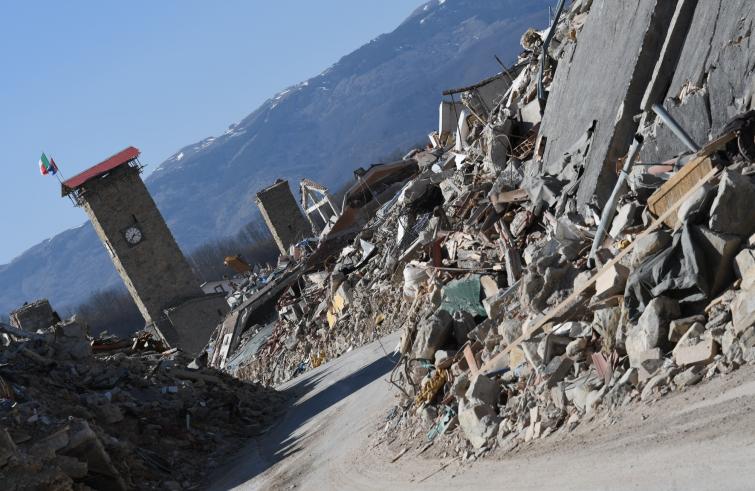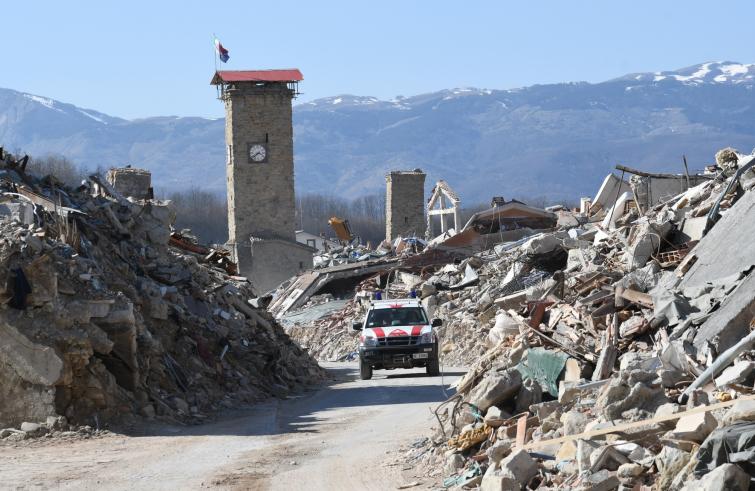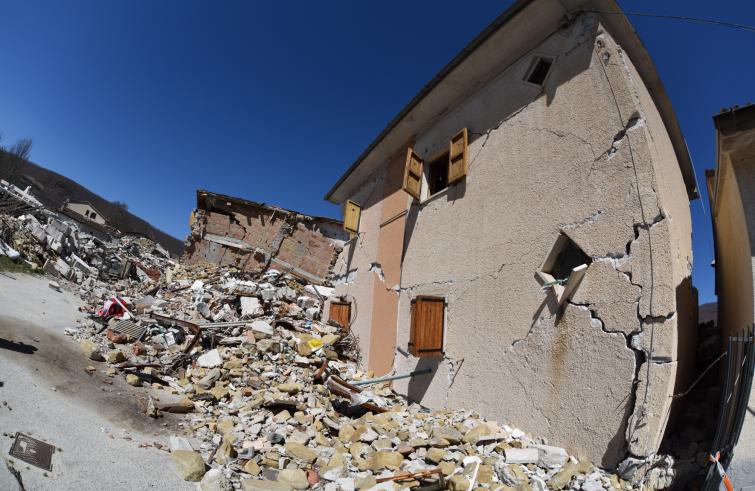
“I was in Lourdes with a group of pilgrims when I received the phone call informing me on what had happened. I hastily returned to Rieti and immediately went to Amatrice where I saw the tragedy that had annihilated the town and that something had changed forever. I can still picture that chaotic situation, and most of all I still see before me the visibly devastated faces of people that have become familiar to me over the past year. We were all speechless.” Msgr. Domenico Pompili, bishop of Rieti, recalled the first moments of the seism that at 3:36 am of August 24 2016, measuring 6.0 on the Richter scale, ripped through the towns of Amatrice, Accumoli, and many helmets and towns in Central Italy, with a death toll of 249 people in the district of Monti della Laga alone, whose names are commemorated in the memorial erected at the Don Minozzi Park in the centre of the city. The past twelve months have been characterised by constant tokens of solidarity and closeness, coupled by difficulties, while the rebuilding drags on amidst heaps of red tape, delays and malfeasance. But hope does not give way, as the bishop reiterated to SIR.
Mons. Pompili, at the funerals for the victims of the seism, celebrated on August 30 2016, your closing words were: “We shall not abandon you, people of the Apennines, the shadow of your home will return to play on your homeland. You shall continue being amazed by dawn.” A year later, do these words preserve their topical relevance? They do indeed. They have been direly challenged, for
the lives of many people have been overwhelmed by feelings of abandonment,
and not without reason. I think this feeling will continue because rebuilding is a long process, resulting not only from the delays in practical procedures, but also because recovering from such a severely-shattered situation is not easy.
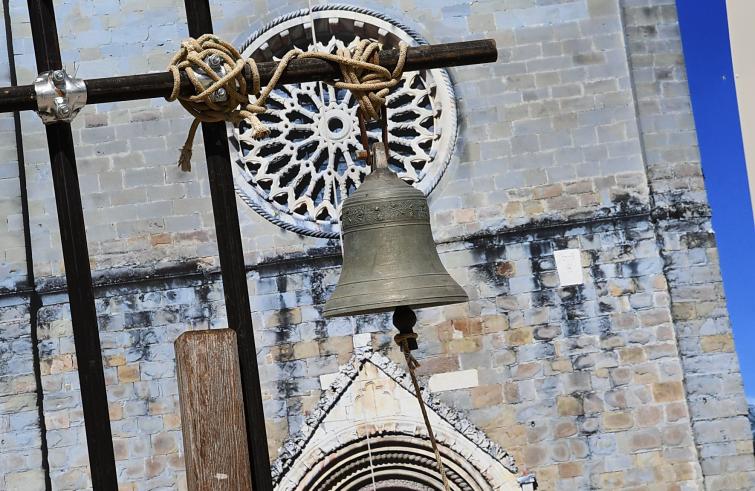
On may occasions, over the past months, you said that the earthquake is “a reality tattooed on our skin”, to the point of saying: “We live from day to day as the terminally ill.” What’s the meaning of “a tattooed” earthquake? It was tattooed because it was a serial seism with mounting consequences, that spread like wildfire involving many other areas in this territory. The earthquake determined a feeling of uncertainty about the future, worsened by the seism that ensued on October 30 and January 18. The growing feeling of precariousness and that there is no hope of seeing tomorrow has become devastating.
Fear has become the travel companion of many people.
We just managed to stem that feeling after a year, but the seism of past July fanned those flames. Those who suffered the night of August 24, or re-lived it through the stories of the survivors, have experienced the slow exhaustion of lifelong certainties. However, at the same time, people have learnt to appreciate more what they have, however fragile and transitional.
How can this feeling of abandonment be soothed? Public institutions, the social and economic fabric and the realm of solidarity ought to step up their mutual cooperation. Institutions must respond not only in situations of emergency but also by planning the reconstruction. The social and economic realms must cooperate because these territories, already experiencing serious difficulties before the seism, ought to find strong motivations in terms of employment, thereby enabling people to return to their peaceful lives. Finally, the outstanding commitment for solidarity must never cease, perhaps with new, effective forms of support.
- foto SIR/Marco Calvarese
- foto SIR/Marco Calvarese
- foto SIR/Marco Calvarese
Reconstruction provides an answer to what is precarious and provisional. What are the lights and shadows of the reconstruction that have come to the fore over the past year? The lights are those we have seen during the emergency stage: the solidarity and the determination of people who continued living in their land despite severe difficulties, especially during the winter months.
And the shadows? The shadows are bound to grow longer unless there are job opportunities and the prospect of a normal life for children. In that case, younger families will be more inclined to remain in the temporary housing facilities. If the attempts to ensure that the majority of inhabitants return to this territory – already suffering demographic depletion before the seism – should fail, there is a risk of utter depopulation. We must look at the future without starting from the past. I am aware that
It’s not possible to rebuild everything as it previously was. Reconstruction must be open to the future,
identifying forms of sustainable presence, capable of providing constructive job opportunities and laying the grounds for social life.
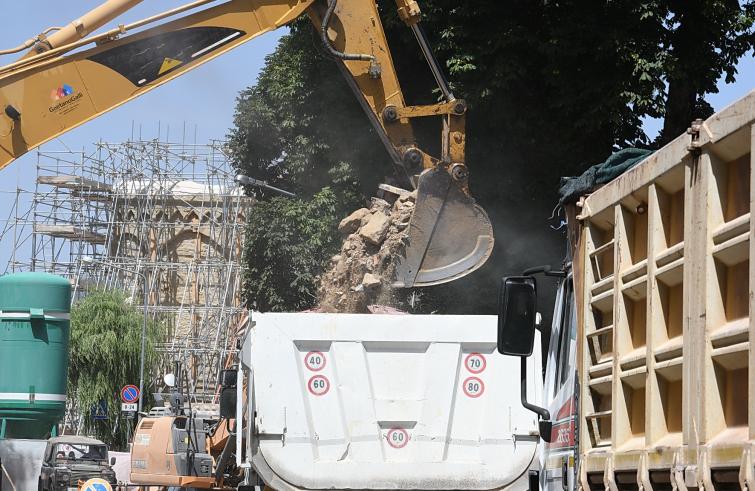
Would the tragedy of the seism be thus transformed into a chance for the future?
Indeed. If the reconstruction takes place mindfully and with everyone’s cooperation, this devastating earthquake could prompt the impetus needed by this territory until today.
This has not been the case up to now: let it suffice to consider the recent episodes of malfeasance connected to reconstruction plans… Whenever money is involved, there is always a surge in questionable interests. But this should not prevent devoting utmost attention to what is being done, in the realistic awareness that vultures could always be there. In order to be effective, the much-needed reconstruction must comply with a specific timeframe that can’t be subjected to delays.
In fact the major challenge of reconstruction involves respecting deadlines and procedures.
Nonetheless, over the past year we have witnessed veritable short-circuits that hindered the reconstruction. What were the causes? It’s a cultural issue: short-circuits take place when responsibilities are at stake since nobody is willing to be exposed to risks. Placing a signature may be a difficult thing to do given the fear of receiving a notice of indictment sooner or later. Fear leads to deadlock. It’s a larger process whereby our generation finds it hard to assume personal responsibilities and refuses to be exposed to some risks. The result is a standstill where everything is stalled with the usual passing of the buck. I firmly believe that the dramatic situation characterising the areas hit by the earthquake should lead everyone to get rid of this mentality, while those standing idly by should take concrete action.
What has been the commitment of the Italian and local church over the past 12 months? First of all we listened to people’s needs and let ourselves be stirred by their suffering, being open to their requests but distinguishing the authentic from the fictitious ones. The concreteness of the interventions stems precisely from a deep perception of people’s difficulties. Our response was customized to their needs after having listened to them. I believe that the population hit by the earthquake has seen the closeness of the Church, conveyed by the many volunteer workers, Caritas, friars, parish priests and through the many forms of aid they received. That token of closeness was also a great opportunity for encounter.

Pope Francis’ visit on October 4 was one of the most significant moments of the past year. What was the impact of the visit, which fruits were borne? The visit left in its wake a style that ought to be cherished, made of concreteness, simplicity and spirituality. Pope Francis embraced the children, the old people, the volunteer workers and operators.
The Pontiff appealed to all of them not to abandon these places.
This is the model we wished to incarnate as a Church. After this experience some people developed the yearning to draw close to the Sacraments, the Eucharist, the spontaneous decision of a journey stirred by the simple fact of “being near.”
How do you imagine the future of this land? I hope it will be as for the other areas that experienced a tragedy such as ours, where disorientation was the first reaction to the earthquake, followed by a slow recovery and even a rebirth. In fact the problem is being “re-born.”
The seism has brought us to our knees but now the hope is that a more fruitful season lies ahead, as it was after the earthquake in Fruili.
August 24 2017: Amatrice returns to be at the centre of everyone’s thoughts. What’s your appeal to the Italian population?
Do continue being near us.
In spite of itself, Amatrice is an icon of our Country that has also been hit by an earthquake, albeit in different forms, which needs to recover – just as our small mountain hamlet – increasing joint participation.

